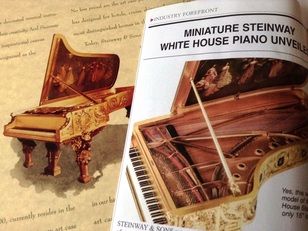
From intricate carvings to ornate legs, the 1903 White House Steinway (now at the Smithsonian’s National Museum of American History) is a richly decorated example of turn-of-the-previous-century piano design and craftsmanship.
But this White House Steinway – the one in the magazine -- isn’t a real Steinway. Is it?
Steinway says it is – and has declared it so. But this Steinway is only 15-inches long. You could probably hold it in your outstretched hands (if they let you). It’s priceless. And perfectly proportioned, down to the most obscure piano detail. It’s not a model. It’s a “real” Steinway, according to the company.
As piano folks say, it’s actionable. It plays!
Each tiny key, wippen, hammer, damper, string and bridge pin works in perfect synchrony with all the other 12,115 grand piano parts to produce real musical notes. A Lilliputian pianist could sit her miniature self down on the instrument’s gilded stool, lift the fallboard and play a concert! And it probably would sound good (in a smallish sort of way), although the article doesn’t say that.
The 1:7 scale Steinway was created by Canadian artist Paul Gentile, who is famous for making other astonishingly accurate small scale musical instruments. In his quest for perfection, he even fashioned a small version of Steinway’s 19th century rim press to help create the piano’s case (it wouldn’t surprise me if he used precisely the number of hard rock maple laminates and the correct glue and procedure to assure authenticity). He even had Steinway’s foundry cast the instrument’s golden plate.
His particular genius and level of obsession clearly qualify Gentile to make a piano, one of the most exacting (and emotionally gratifying) undertakings in the world.
Of course, Steinway has created instrument after instrument for more than 160 years, ever since the company’s German immigrant founder, Heinrich Engelhard Steinweg, built the first one in his Manhattan kitchen. To this day, each Steinway has an individual allure that must be matched to the player, although all Steinways share the same exalted pedigree.
Gentile’s gilded miniature, apparently, is no exception.
But what’s so eminently instructive about the mere existence of this miniature art case piano is the gilded reputation Steinway & Sons has crafted for itself over the years. Through times of uncertainty and change, they have built their brand on a foundation of excellence, as described initially by the man who became known as Henry Engelhard Steinway.
“Build the best piano possible,” he instructed. Then “sell it at the lowest price consistent with quality.”
That price has continued to rise, to the point where a Steinway concert grand can set you back around $150,000 (closer to $200,000 with certain veneered cases). Steinway prices increase by a predictable chunk every year, but there’s no shortage of discerning buyers willing to invest in new Steinways or plunk down the cash for quality rebuilt ones, especially those restored in the company's own shop.
Quality is a difficult notion to put your finger on because it’s experienced in the eye (or ear) of the beholder. Even so, through a combination of old world craftsmanship and diligent brand building over the years, Steinway & Sons pianos have managed to become the quality standard to which others are most often compared – particularly at the concert performance level, whether the grand on stage is a New York Steinway or a Hamburg Steinway. Of course, other exquisitely-crafted pianos from low volume (mostly European) makers also are available to performers, each with its unique appeal and devotees. But there’s still only one Steinway.
It’s just that now one of them is very, very small.
TakeAway: Build your brand brick by authentic brick. In time, perhaps you can become the standard by which your competitors are judged. And maybe then some famous artist will take the time to honor you by creating a working miniature of your product.

 RSS Feed
RSS Feed